The Big Spin
In my younger days, when I had small children, I seemed to get a lot more spinning done. How could that be? Children alone are a full time job, and I had a small family farm to take care of: sheep, chickens, pigs, goats, an orchard and garden. There was canning and cleaning and carpooling....and yet? I spun and wove a lot.
I thought back to how my day was ordered, and the one thing that struck me is that I got up early every day, before the boys were awake, fed the sheep, goats and chickens, and sat down to spin with a cup of coffee and NPR's morning news on the radio until they woke up. About an hour a day. Every day. The wheel sat waiting for me by my chair, and it was my time to myself, before the world woke up and the day went into overdrive.
What does one hour a day mean, in terms of spinning production? This week, I set out to find out:
Spin one hour a day, not speed-spinning or time-trials, just regular, listen-to-the-news-and-spin spinning, and see how much can be done in a week. 7 days. 7 hours.
My spinning wheel in those days was a Norwegian Saxony built by Michael Wilson, long gone, both wheel and maker. I sold it many years ago in my quest for ever-faster spinning equipment. So, to replicate the type of spinning I did then, I chose to use a standard wheel (Lendrum upright) with a regular flyer (actually, I think it's the flyer called the Fast Flyer, but it's not the Very Fast Flyer). Using equipment similar to what I was using in those long ago days-of-remembered-production.
First, I had to clear bobbins:
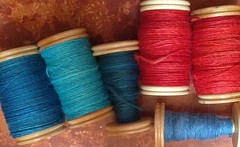
I use this wheel, this flyer for spinning yarn for rugs now: this is Wensleydale from several dyers: Lisa Souza, Gnomespun, Fiber Optics...all spun to use in knotted pile. I have lots of fiber to spin, some of it more for sweaters and mitts and hats, so I would pull some of that fiber out, and set to spinning a two ply yarn for a sweater.
I got out the kitchen timer, and sat down to spin the first bobbin on the first day:
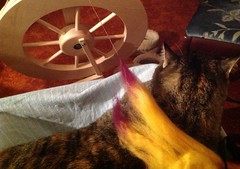
Oops. I had unexpected help. I left her there, happily purring away while I spun. This is everyday production, not a speed trial, so we went with everyday circumstances :).
Here is the first hour:
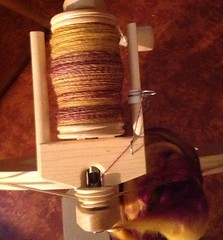
At this point I realized I had forgotten to take a picture of the fiber! So, after one bump spun, I took a photo of the remaining 3:

I started with 4, 4 ounce bumps of Polwarth, dyed by Schafenfreude Fibers in a very nice coppery gold that I could not resist buying. But then....I also could not resist adding more color: I put all four braids into the dyebath with some violet dye. Crammed into the dyebath, the dye penetrated unevenly, making this nice conglomeration of violet, copper and gold. The plan for the yarn? A sweater, in a 2 ply yarn slightly larger than sport weight. In other words, my standard default spinning.
I stopped after an hour, even though In Real Life I would add more to the bobbin, and took it off, prepared to start fresh the next morning: new bobbin, continue with the same fiber, spin one hour only. Day two:

Looks much the same as Day One, perhaps a bit less on the bobbin. There was no obvious reason for that, no cat this time! But energy, thoughts, news and concentration each day is different...
The two days together:
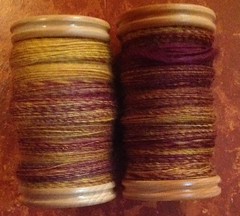
Day one on the left, day two on the right. Definitely less on day two.
I spun for five days, each day starting with a fresh bobbin, continuing with the same fiber. After less than six days, the fiber was done:

That's one pound, 4 four ounce braids of Polwarth. But on day six, I'd only spun for 26 minutes! So, I got out more fiber, similar in color and fiber-type:
Fine wool, dyed by Chic Thrills, in a colorway that was similar to the Polwarth, and would ply up nicely with it:
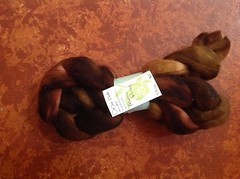
I spun this during the remaining 34 minutes of the hour on the sixth day:
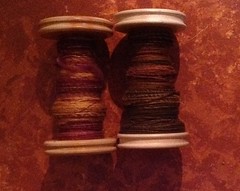
and finished on the seventh day:
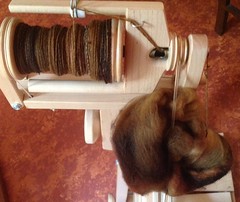
Seven days, and hour a day, default fine wool singles:
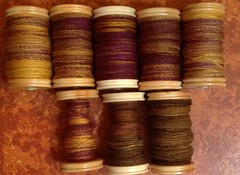
The stats:
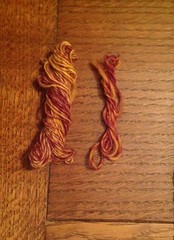
I pulled off a meter (thinking I would go all metric, why I do not know) and it weighed in a 0.3gm. That was too small! I pulled off ten yards (now you're talking) (left) and it weighed 0.08 oz. This translates to 2000 yards per pound. 2000 yards! in a week! I am quite happy with those numbers :).
Since it will eventually be plied, there is more time to invest, certainly, but less than seven hours invested so far in the spinning. If it were half the time, (a guess, probably wildly inaccurate) that's ten hours +/- in a pound and a quarter of wool.
One pound, four ounces. No pressure, no goal, just spin and see what happens. I was surprised...I can, could!, spin a pound a week if I just sat down to do it, everyday. Every. Day. Think of it: 52 pounds a year. That makes the stash seem...well, if not realistic, at least less of a monster in bins. Do-able.
The issue is the sitting-down-and-doing-it. Of course, life intervenes, there are times when sitting down everyday is not possible. I'm away from home a lot, now, for example, and in those days of small-children-sheep-and-chickens, I was home all the time. Every day. For years.
But there is hope: a little bit each day, and those bins of fiber? Will spin right up.
But now? Off to the airport! Whoops! I'll have knitting with me :).
I thought back to how my day was ordered, and the one thing that struck me is that I got up early every day, before the boys were awake, fed the sheep, goats and chickens, and sat down to spin with a cup of coffee and NPR's morning news on the radio until they woke up. About an hour a day. Every day. The wheel sat waiting for me by my chair, and it was my time to myself, before the world woke up and the day went into overdrive.
What does one hour a day mean, in terms of spinning production? This week, I set out to find out:
Spin one hour a day, not speed-spinning or time-trials, just regular, listen-to-the-news-and-spin spinning, and see how much can be done in a week. 7 days. 7 hours.
My spinning wheel in those days was a Norwegian Saxony built by Michael Wilson, long gone, both wheel and maker. I sold it many years ago in my quest for ever-faster spinning equipment. So, to replicate the type of spinning I did then, I chose to use a standard wheel (Lendrum upright) with a regular flyer (actually, I think it's the flyer called the Fast Flyer, but it's not the Very Fast Flyer). Using equipment similar to what I was using in those long ago days-of-remembered-production.
First, I had to clear bobbins:

I use this wheel, this flyer for spinning yarn for rugs now: this is Wensleydale from several dyers: Lisa Souza, Gnomespun, Fiber Optics...all spun to use in knotted pile. I have lots of fiber to spin, some of it more for sweaters and mitts and hats, so I would pull some of that fiber out, and set to spinning a two ply yarn for a sweater.
I got out the kitchen timer, and sat down to spin the first bobbin on the first day:

Oops. I had unexpected help. I left her there, happily purring away while I spun. This is everyday production, not a speed trial, so we went with everyday circumstances :).
Here is the first hour:

At this point I realized I had forgotten to take a picture of the fiber! So, after one bump spun, I took a photo of the remaining 3:

I started with 4, 4 ounce bumps of Polwarth, dyed by Schafenfreude Fibers in a very nice coppery gold that I could not resist buying. But then....I also could not resist adding more color: I put all four braids into the dyebath with some violet dye. Crammed into the dyebath, the dye penetrated unevenly, making this nice conglomeration of violet, copper and gold. The plan for the yarn? A sweater, in a 2 ply yarn slightly larger than sport weight. In other words, my standard default spinning.
I stopped after an hour, even though In Real Life I would add more to the bobbin, and took it off, prepared to start fresh the next morning: new bobbin, continue with the same fiber, spin one hour only. Day two:

Looks much the same as Day One, perhaps a bit less on the bobbin. There was no obvious reason for that, no cat this time! But energy, thoughts, news and concentration each day is different...
The two days together:

Day one on the left, day two on the right. Definitely less on day two.
I spun for five days, each day starting with a fresh bobbin, continuing with the same fiber. After less than six days, the fiber was done:

That's one pound, 4 four ounce braids of Polwarth. But on day six, I'd only spun for 26 minutes! So, I got out more fiber, similar in color and fiber-type:
Fine wool, dyed by Chic Thrills, in a colorway that was similar to the Polwarth, and would ply up nicely with it:

I spun this during the remaining 34 minutes of the hour on the sixth day:

and finished on the seventh day:

Seven days, and hour a day, default fine wool singles:

The stats:

I pulled off a meter (thinking I would go all metric, why I do not know) and it weighed in a 0.3gm. That was too small! I pulled off ten yards (now you're talking) (left) and it weighed 0.08 oz. This translates to 2000 yards per pound. 2000 yards! in a week! I am quite happy with those numbers :).
Since it will eventually be plied, there is more time to invest, certainly, but less than seven hours invested so far in the spinning. If it were half the time, (a guess, probably wildly inaccurate) that's ten hours +/- in a pound and a quarter of wool.
One pound, four ounces. No pressure, no goal, just spin and see what happens. I was surprised...I can, could!, spin a pound a week if I just sat down to do it, everyday. Every. Day. Think of it: 52 pounds a year. That makes the stash seem...well, if not realistic, at least less of a monster in bins. Do-able.
The issue is the sitting-down-and-doing-it. Of course, life intervenes, there are times when sitting down everyday is not possible. I'm away from home a lot, now, for example, and in those days of small-children-sheep-and-chickens, I was home all the time. Every day. For years.
But there is hope: a little bit each day, and those bins of fiber? Will spin right up.
But now? Off to the airport! Whoops! I'll have knitting with me :).


















